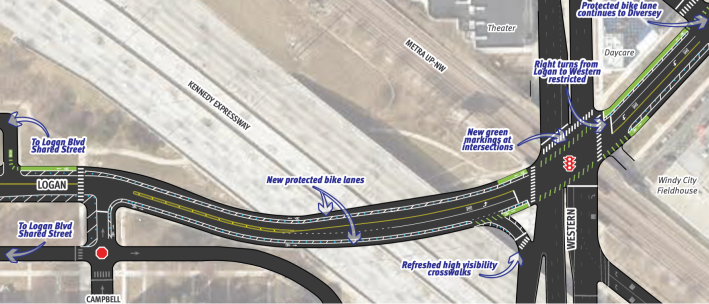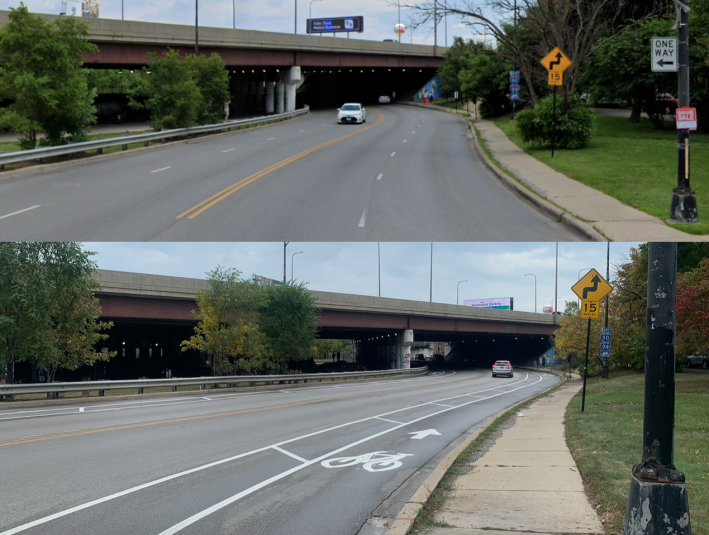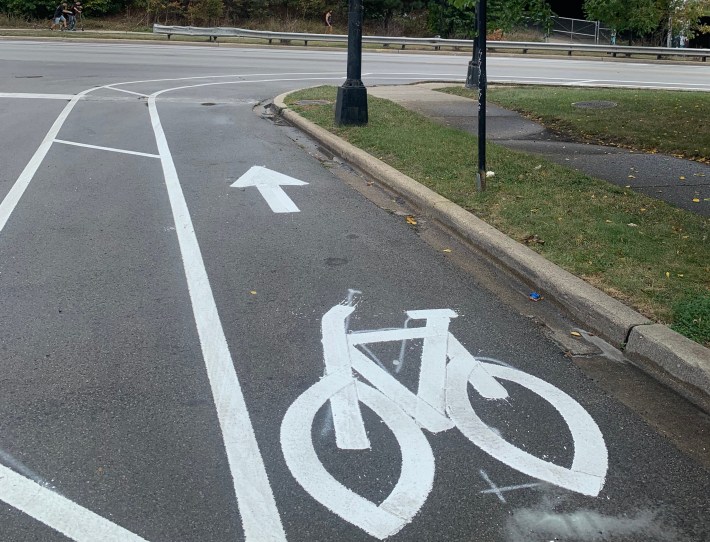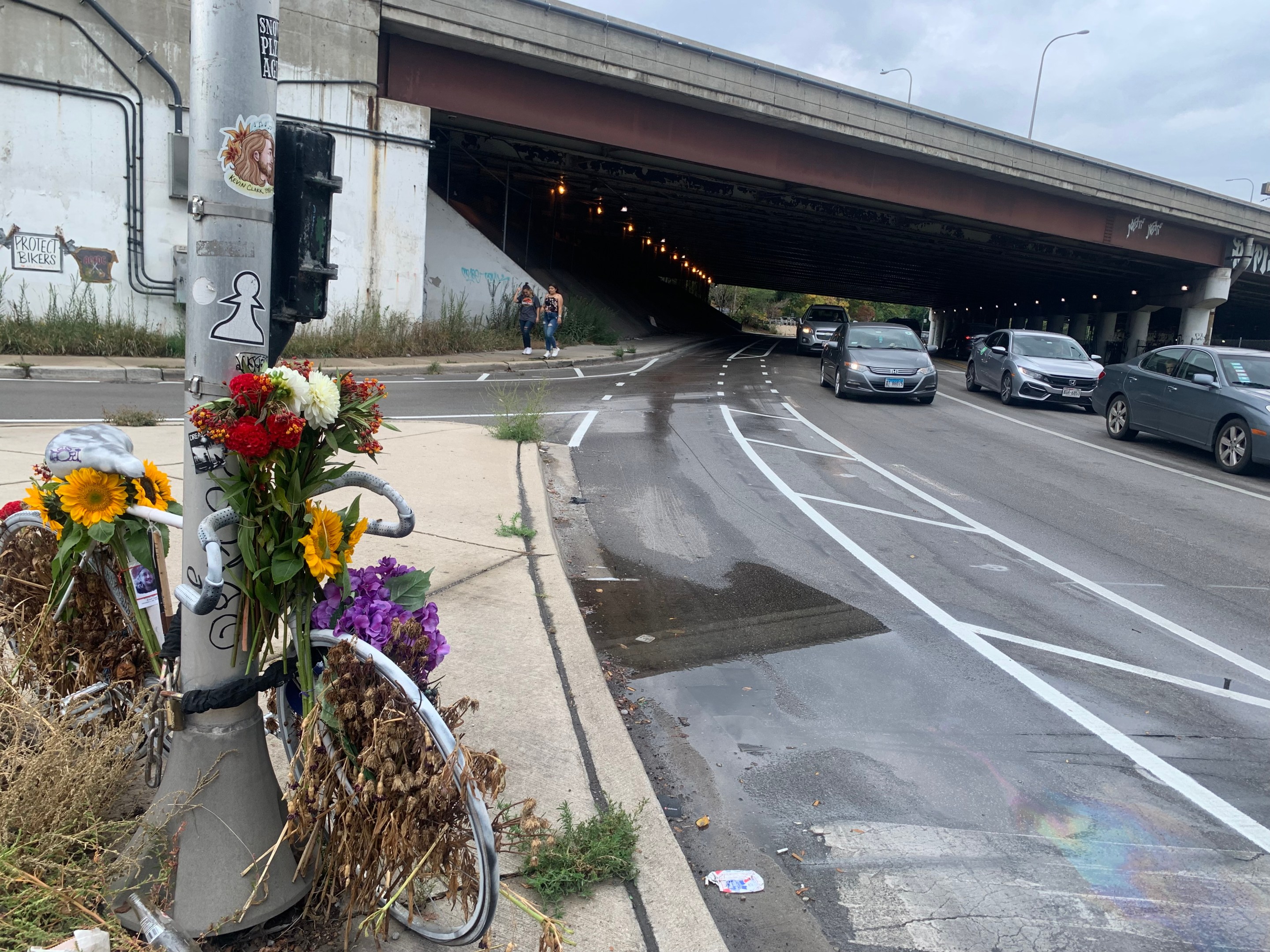Logan Boulevard, which runs east from the Milwaukee/Kedzie traffic circle to Western Avenue and then angles northeast to meet up with Diversey Avenue at the river, is one of the most convenient bike routes between Lakeview /Lincoln Park and Northwest Side neighborhoods like Logan Square. But this stretch also contains what has been one of the most dangerous intersections for cyclists. At Western where the service drives of the boulevards end, the shoulder disappears, and the Kennedy Expressway and Metra tracks obstruct sight lines where two four-lane streets meet. Kennedy access ramps further complicate the situation.
Until this weekend, four lanes of fast-moving vehicle traffic filled Logan curb-to-curb under the overpasses. Cyclists were forced to endure drivers whizzing by them at close range or else “take the lane” around a nearly blind curve, or hop on the sidewalk until they passed the hazardous intersection.
In 2008, a driver struck and killed videographer Tyler Fabeck, 22, on his bike at this chaotic junction. The Active Transportation Alliance released recommendations for safety improvements to the the intersection in 2018, such as eliminating a travel lane for a short segment, new bike lanes and crosswalks, and better lighting. However, government officials took no action.
On May 26 of this year a 20-year-old driver fatally struck “School of Rock” drummer Kevin Clark, 32, while he was cycling through the intersection. This sparked renewed calls for fixing the intersection from loved ones of the fallen cyclists and bike advocates. Last month month the Chicago Department of Transportation finally announced that protected bike lanes were planned for Logan Boulevard near the intersection.

A graphic of the new street design provided by CDOT showed that in general two of the four mixed-traffic lanes on Logan would be converted to curbside bike lanes with striped buffers and flexible plastic posts between the bike lanes and moving traffic. The bike lanes would be striped through the Western intersection with green paint. Right turns from westbound Logan onto Western would be banned.
CDOT recently started implementing the project. As of yesterday the "road diet" was in effect, with the conversion of mixed-traffic lanes to bike lanes starting at Maplewood Avenue (one block west of the eastern terminus of the service drives) and continuing to Western. The department plans to install flexible posts in the striped buffers of the bike lanes to further delineate them.

Cyclists traveling east on the southernmost service drive are directed north on Campbell to the bike lane that takes them comfortably east to Western Avenue. Westbound riders have a bike lane from Western to the entrance of the northernmost service drive at Campbell. CDOT will also install curbside bike lanes with flexible posts from from Western to Diversey.

As a Northwest Sider since the mid-2000’s, I’ve been biking this route for the better part of two decades and not once have I stayed in the road on that blind curve under the Metra overpasses – until this afternoon. While it's true "paint is not protection," it can make a helluva difference, especially when sufficient room is allotted for bikes. I felt completely comfortable riding on Logan all the way from the east side of Milwaukee Avenue to Western Avenue, a truly liberating experience. The road diet even seemed to calm traffic a bit, with cars slowing down to merge instead of speeding up around the curve.
It should be noted that I’m writing this on a Sunday afternoon; it remains to be seen if rush-hour drivers are as relaxed and agreeable to the new road rules. Traffic diverters, or at least speed humps, should be installed on the service drives, to discourage or prevent motorists from using the service drives as a cut-through around traffic on the center lanes of the boulevard.
The buffered lanes west of the intersection are tremendous, welcome, and long-overdue improvements for bicycle safety, and they should work better after the posts are installed, which will make the lanes more visible to drivers. But until the new lanes are installed on Logan east of Western to Diversey, that stretch will remain sketchy.
Logan re-widens – somewhat ambiguously – to four lanes east of western, and the eastbound bike route is still only marked by faded sharrows (bike-and-chevron "shared-lane markings"), putting bicyclists dangerously close to the path of impatient drivers roaring from a stop, or attempting to squeeze past to turn right into the Target parking lot. And then there’s the frequently nerve-wracking experience of crossing over to the striped bike lane that reappears just before Elston between the through lanes and right turn lanes.
While the start of the street remix is great news, unfortunately Streetsblog Chicago heard about it because someone on a bike was already struck in the new lanes, according to a Reddit user. Fortunately, they said it was a minor collision and the cyclists was uninjured.
Here's the link to the Reddit post on the incident.https://t.co/RYMPSbs7C3
— Streetsblog Chicago (@streetsblogchi) October 3, 2021
But it begs the question, why doesn't CDOT include a physical barrier to protect cyclists from drivers in all protected bike lanes? The flexible posts, which raise driver awareness of the lanes, but are fairly useless for stopping motorists from entering them.
Innovative approach to fixing a dangerous highway-like urban road:Baltimore creates a bike and walk path using just a lane and a row of plastic jersey barriers. More here: https://t.co/IWn3OaRuXD pic.twitter.com/F2wIL2qIH1
— Streetsblog USA (@StreetsblogUSA) July 16, 2018
It's understandable that CDOT usually doesn't install concrete curb protection when protected bike lanes debut, in case the design needs to be tweaked. But why not use Jersey walls, which can be moved if necessary? Doing this on the welcome new Logan lanes would make them even better.





